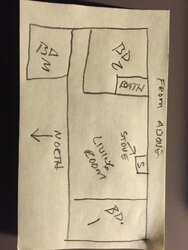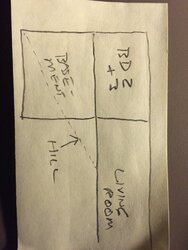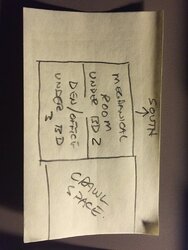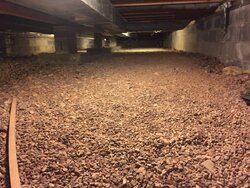- Aug 6, 2007
- 442
Wood stove, add on furnace, pellet stove, insert or stove style, etc, etc. Ive thought I had a decent handle on which way I wanted to go with regard to heating my home but I keep running into major (expensive) obstacles that still leave me with a major hole in my end goal. Rather than post up another thread about a specific option, I'm hoping the collective hive here can help me decide what might be my best option.
Home - 25 years old, 1500 sq ft. 1000 sq ft upstairs, ranch style, 500 sq ft partial walk out basement. I'm on a hill in Very Northern Arkansas. Ive had a wood stove from Home Depot in my living room for quite a few years now and it is getting old and needing to be replaced. The stove is in my living room mostly in the center of the upstairs so the ceiling fan in the living room helps to broadcast the heat. It is piped thru to a wall thimble, over to a T and up 15'. All high temp SS pipe.
Now, what has me looking at all and any options is that my office (and my wifes) is in my basement and it is always cold. We are all electric and the space heaters and radiator style heaters are not only impacting our electric bill but they just don't work well. I've added insulation but we both are tired of frozen fingers when we try to write or type. lol So I was looking at an add on furnace but it developed into a very expensive venture. I considered moving my stove into my basement but all I've read tells me that is a mixed bag of results. I was even reading about a wetback system to run hot water into a radiator in my basement off my current stoves location (down 3' into the crawlspace, over 18' and down to radiator) but I just don't see that as working well. I thought about taping into my marathon water heater for a basement radiator but I have no idea how that would impact my electric bill.....would it be better or worse than the space heaters?
I'm really confused as to the best route to take so if anyone has any suggestions on an option I've not considered or an option I've written off that may work and I didn't realize, etc, please let me know. I'm all ears at this point. All I know is I need to do something before next Winter. Thank you in advance for the help.
Home - 25 years old, 1500 sq ft. 1000 sq ft upstairs, ranch style, 500 sq ft partial walk out basement. I'm on a hill in Very Northern Arkansas. Ive had a wood stove from Home Depot in my living room for quite a few years now and it is getting old and needing to be replaced. The stove is in my living room mostly in the center of the upstairs so the ceiling fan in the living room helps to broadcast the heat. It is piped thru to a wall thimble, over to a T and up 15'. All high temp SS pipe.
Now, what has me looking at all and any options is that my office (and my wifes) is in my basement and it is always cold. We are all electric and the space heaters and radiator style heaters are not only impacting our electric bill but they just don't work well. I've added insulation but we both are tired of frozen fingers when we try to write or type. lol So I was looking at an add on furnace but it developed into a very expensive venture. I considered moving my stove into my basement but all I've read tells me that is a mixed bag of results. I was even reading about a wetback system to run hot water into a radiator in my basement off my current stoves location (down 3' into the crawlspace, over 18' and down to radiator) but I just don't see that as working well. I thought about taping into my marathon water heater for a basement radiator but I have no idea how that would impact my electric bill.....would it be better or worse than the space heaters?
I'm really confused as to the best route to take so if anyone has any suggestions on an option I've not considered or an option I've written off that may work and I didn't realize, etc, please let me know. I'm all ears at this point. All I know is I need to do something before next Winter. Thank you in advance for the help.






